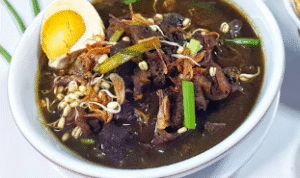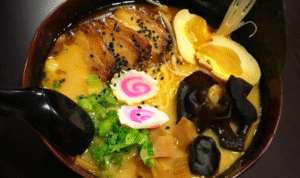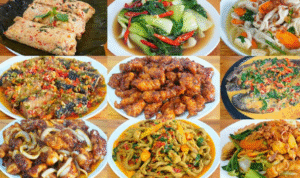Reseprakyat.com – Soy sauce chicken has long been a staple in Indonesian families. The combination of the sweetness of soy sauce and the savory seasonings makes this dish always tempting, whether served for lunch or dinner. Many people think that making delicious soy sauce chicken requires complicated cooking techniques or a long time. However, with simple ingredients and the right steps, this dish can be prepared quickly without sacrificing its flavor. This article will thoroughly discuss how to cook tender soy sauce chicken that perfectly absorbs the spices, as well as providing various tips, variations, and presentation tricks to make this home-cooked dish taste like a restaurant meal.
In addition to the basic recipe, you’ll also find inspiration for flavor variations, from sweet and spicy to fragrant ginger, to low-sodium versions suitable for a healthy diet. This discussion will give you more confidence in cooking, whether for a small family, a gathering with friends, or as a food business idea. Let’s start by understanding the ingredients needed, then move on to cooking instructions, tips for success, and creative presentation ideas.
A Practical & Savory Soy Sauce Chicken Recipe: The Secret to Home Cooking That’s Always a Favorite
Main Ingredients and Their Functions
When cooking soy sauce chicken, choosing the right ingredients is crucial to the final result. Chicken is the star. You can choose free-range chicken, which has firmer meat, or regular broiler chicken, which has a softer texture. Each type of chicken has a distinct flavor. Free-range chicken offers a deeper savory sensation, while broiler chicken tends to tenderize more quickly.
Sweet soy sauce is the key to the sweet and savory flavor. Choose a quality soy sauce with a thick texture and a balanced sweetness. Garlic and shallots are the base spices, providing a fragrant aroma and delicious flavor. The addition of oyster sauce is optional, but it enhances the umami flavor, making the dish richer.
Other spices, such as ginger and scallions, add a fresh touch and enhance the aroma. Water is used to aid the cooking process, allowing the spices to penetrate the meat. Cooking oil is needed to sauté the spices before adding the chicken, allowing the garlic flavor to be more pronounced and fragrant.
Ingredients List (for 4 servings)
- 500 grams of chicken, washed and drained
- 4 cloves of garlic, finely chopped
- 2 shallots, thinly sliced
- 5 tablespoons thick sweet soy sauce
- 1 tablespoon oyster sauce (optional)
- 1 teaspoon salt or to taste
- ½ teaspoon ground pepper
- 1 piece of ginger, bruised
- 150 ml water
- 2 tablespoons oil for sautéing
- 2 stalks of spring onions, roughly chopped
- 1 large red chili, sliced diagonally (optional)
Preparation Before Cooking
Good preparation will make cooking easier. First, make sure the chicken is thoroughly cleaned to remove any fishy odors. You can soak it briefly in lime juice or vinegar, then rinse under running water. Finely chop the garlic to distribute the spices evenly when sautéing. Crushed ginger releases essential oils that impart a fresh aroma.
Prepare all spices and ingredients on the kitchen counter. The habit of preparing “mise en place”—a culinary term for arranging ingredients before cooking—makes the cooking process neater and faster. Heat a wok or saucepan wide enough to allow the chicken to cook evenly and the spices to blend thoroughly.
Steps for Cooking Soy Sauce Chicken
- Sautéing the Basic Seasonings
- Heat oil in a skillet over medium heat. Sauté garlic, shallots, and ginger until fragrant and golden brown. This process is important because well-cooked spices will release a delicious aroma that forms the foundation of the dish’s flavor.
- Adding the Chicken
- Add the chicken pieces to the skillet. Stir well until the surface of the chicken changes color and browns slightly. This process helps lock in the juices, keeping the meat juicy.
- Seasoning
- Pour in the sweet soy sauce, oyster sauce, salt, and pepper. Stir again until all the chicken pieces are evenly coated with the spices.
- Adding Water and Slow Cooking
- Pour water into the skillet. Cover the skillet and cook over low heat for about 20 minutes, or until the chicken is fully cooked and the spices have absorbed. Stir occasionally to prevent the spices from burning on the bottom.
- Finishing Touch
- Add sliced spring onions and red chilies if you prefer a little spiciness. Stir briefly and then turn off the heat. The soy sauce chicken is ready to serve.
Tips for Successfully Cooking Soy Sauce Chicken
- Use Low Heat When Thickening the Sauce
- Cooking over low heat allows the spices to penetrate the meat and the sauce to thicken naturally without the need for a thickener.
- Let the Chicken Marinate Before Cooking
- If time permits, marinate the chicken in soy sauce for 15–30 minutes before cooking for a deeper flavor.
- Choose Quality Soy Sauce
- The sweetness and savory flavors are greatly influenced by soy sauce. Try several brands until you find the one that best suits your family’s tastes.
- Use a Non-Stick Pan
- A good pan will help the soy sauce caramelize and prevent the spices from burning.
Flavor Variations to Try
- Sweet and Spicy Soy Sauce Chicken
- Add red chili peppers or chili powder for a tantalizing spicy kick. Perfect for spicy food lovers.
- Fragrant Ginger Soy Sauce Chicken
- Add grated ginger for a fresh aroma and warm flavor. This variant is popular during the rainy season for its warming effect.
- Balinese Spiced Soy Sauce Chicken
- Use Balinese spices with lime leaves and lemongrass. The fragrant blend of spices enhances the flavor.
- Low-Sodium Soy Sauce Chicken
- For a healthy diet, reduce the salt and use low-sodium soy sauce. The flavor remains delicious when cooked slowly to allow the spices to penetrate.
Nutritional Value and Benefits
Chicken is a high source of protein, which is essential for cell growth and repair. Sweet soy sauce contains simple carbohydrates that provide energy, while garlic is known for its antibacterial properties and helps boost the immune system. Ginger has a warming effect that is beneficial for digestion. Serving soy sauce chicken with boiled or stir-fried vegetables adds fiber and vitamins, making it a balanced meal for the family.
Serving Suggestions
Soy sauce chicken is best served with warm white rice. Sprinkle fried onions on top for a crunchy texture. To complement, add sautéed water spinach or capcay vegetables. For a more appealing presentation, place the soy sauce chicken on a large serving plate and garnish with sliced red chilies and spring onions.
For special occasions, you can serve it with uduk rice or yellow rice. The sweet and savory combination of soy sauce chicken and coconut milk-seasoned rice will delight your guests.
Storage and Reheating Tips
If cooking in large quantities, soy sauce chicken can be stored in the refrigerator for two to three days. Store in an airtight container to maintain freshness. When reheating, use low heat and add a little water to prevent the sauce from becoming too thick and maintain a delicious flavor. Avoid reheating to maintain nutritional quality and flavor.
Creative Ideas for Utilizing Leftover Soy Sauce Chicken
Leftover soy sauce chicken can be repurposed into new dishes. For example, shred the chicken and use it as a bread filling or a topping for fried noodles. You can also add it to fried rice for a distinctive sweet and savory flavor. With a little creativity, no food goes to waste.
Conclusion
This practical and savory soy sauce chicken recipe is a quick solution for a delicious and nutritious family meal. With simple ingredients, easy cooking steps, and a variety of flavors, you can create a special menu anytime. The tips shared, from ingredient selection to storage, ensure this dish remains delicious even when cooked in large quantities. Make soy sauce chicken a mainstay that not only delights the palate but also warms the atmosphere around the dinner table.








Comment